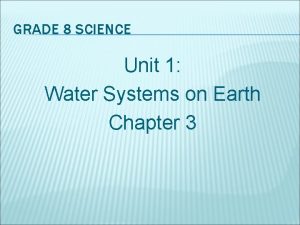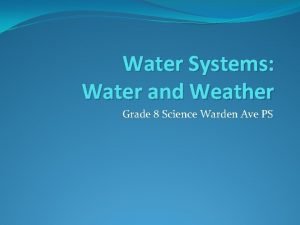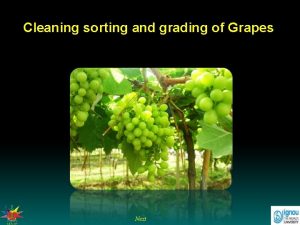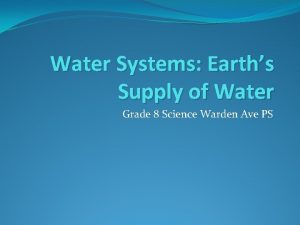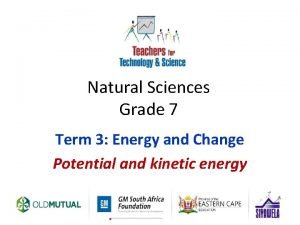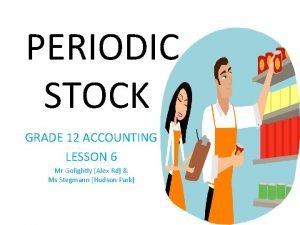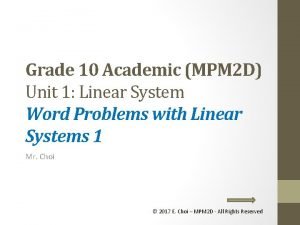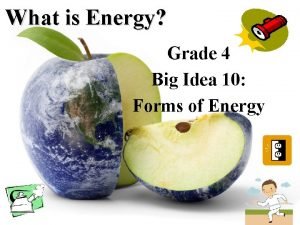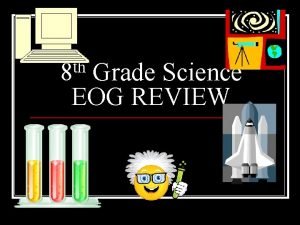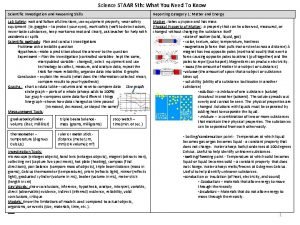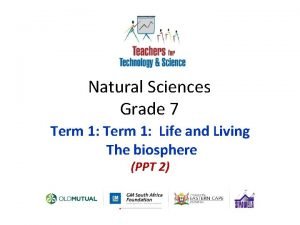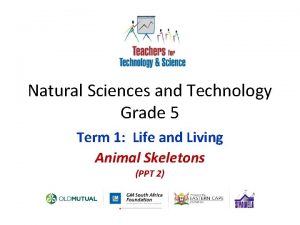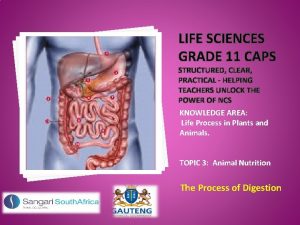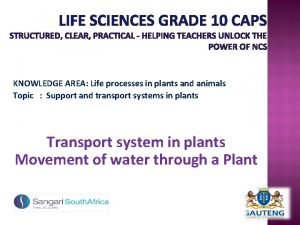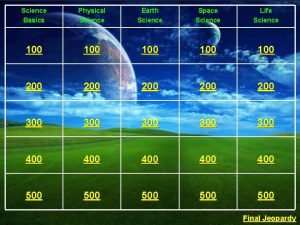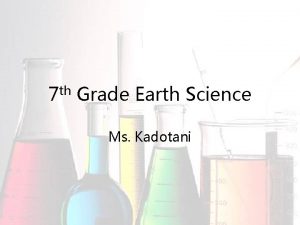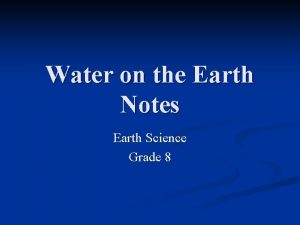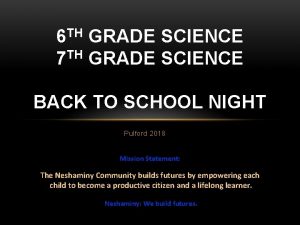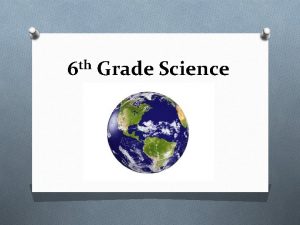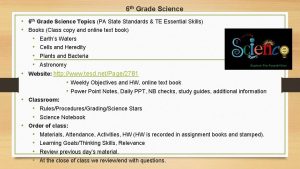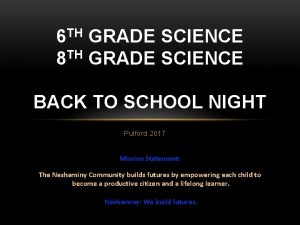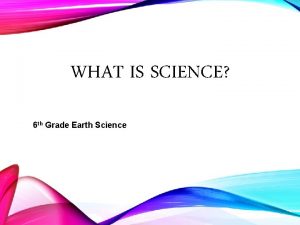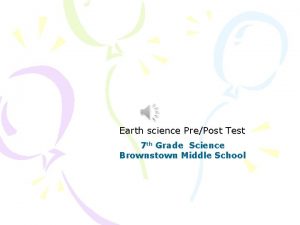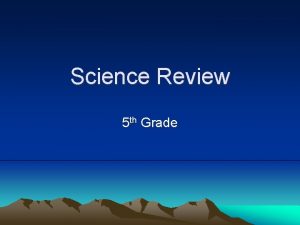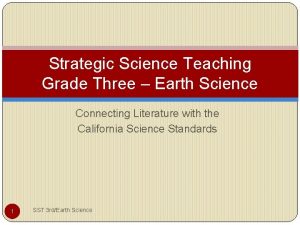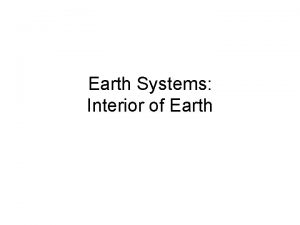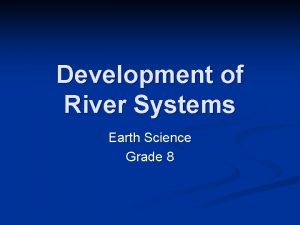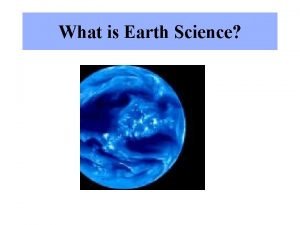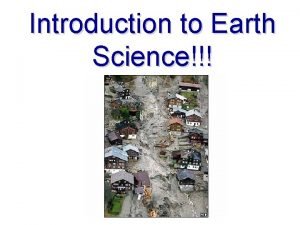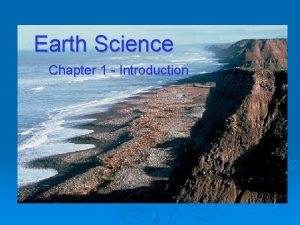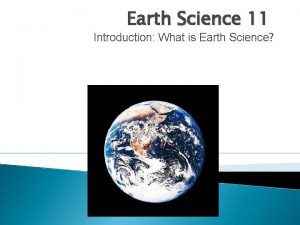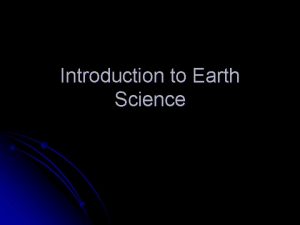Earth Systems 8 th Grade Earth Science Earth































- Slides: 31

Earth Systems -8 th Grade Earth Science


• Earth is much more than rock and soil. • Earth consists of four major spheres: the hydrosphere, atmosphere, solid Earth, and biosphere. • All four of these spheres continuously interact with each other.

is a dynamic mass of liquid that is continually on the move, from the oceans to the atmosphere, precipitating back to the land, and running back to the ocean. • The most prominent feature of the hydrosphere is the global ocean, blanketing nearly 71% of the Earth’s surface. • The hydrosphere also consists of freshwater such as streams, lakes, and glaciers as well as water found underground. • 97% of all water is oceanic, only 3% is fresh water sources.

Atmosphere • The Atmosphere is a live giving gases envelope that encases the Earth. • More than three quarters of the atmosphere is made up of nitrogen and most of the rest is oxygen. However it is the remaining 1%, a mixture of carbon dioxide, water vapor and ozone, that not only produces important weather features such as cloud and rain, but also has considerable influence on the overall climate of the Earth, through mechanisms such as the greenhouse effect and global warming. • Without atmosphere the Earth would be much like the moon! No movement and no life.

Solid Earth • Solid Earth is all that lies beneath the atmosphere and ocean. • Solid Earth is divided into three principal units: the dense CORE; the less dense MANTLE; and the CRUST which is the least dense and very thin outer “skin” of the Earth. • Crust is divided into two divisions: Oceanic Crust and Continental Crust. • Oceanic crust is below the ocean. • Continental crust is the solid Earth that creates the continents.


Biosphere • Biosphere includes all life on Earth and consists of the parts of the solid Earth, hydrosphere, and atmosphere in which living organisms can be found. • Living organisms help to change the physical environments in which they live. • Without life, the makeup and nature of solid Earth, atmosphere, and hydrosphere would be very different.

Earth as a system • All four spheres are connected and interact constantly. Together they produce a complex and continuous interaction called Earth System • A SYSTEM is a group of interacting, or interdependent parts that form a complex whole. • A change in one part of the Earth system can produce changes in any or all of the other parts • Can anyone give an example?

Volcanic Eruption!!! But how does it include each part of the Earth system?

• Lava from the Earth’s interior and could block nearby valleys. This obstruction could cause a lake or a change in stream direction. • Ash from the explosion enters the atmosphere. This ash covers the sky resulting in temperature changes. • The lava and ash cover the pre-existing land becomes a new land surface. Forcing new biotic organism out of previous habitats. Additionally, it creates new land for new organism to inhabit and grow.

Earth System

Earth system • Two sources of energy – Sun – Interior of Earth • The sun is the driving force behind external processes within the hydrosphere, atmosphere, and at the Earth’s surface. • Interior of the Earth drives the internal processes that produce volcanoes, earthquakes, and mountains

• Environment refers to everything that surrounds and influences an organism. – Both living and nonliving. • Physical environment includes the nonliving factors such as: – Water, air, soil, and rock, temperature, , humidity and sunlight.

Resources Renewable • Plants and animals for food • Natural fibers for clothes • Forest products for lumber & paper • Flowing water, sun, wind Non-renewable • Oil • Copper, Iron, Aluminum • Natural gas • Coal

Human Population Possibly exponential growth 2012

Environmental problems Human induced Natural hazards • Urban air pollution • Earthquakes • Acid rain • Landslides • Ozone depletion • Tornadoes • Global warming • Hurricanes • Contamination and depletion of water resources • Floods • Drought

Scientific Inquiry • Science is based on the assumption that the natural world behaves in a consistent and predictable manner. • The Goal = discover underlying patterns in the natural world and then use the knowledge to predict what will or will not occur.

Scientific Method -Though not a fixed path, scientist usually use the following steps to investigate phenomena. 1. Collect scientific data/facts through observation and measurement 2. Develop one or more HYPOTHESES to explain these facts *HYPOTHESIS – A tentative explanation that is tested to determine if it is valid.

Continued… 3. Develop observations and experiments to test the hypothesis. 4. Decide whether the test result show whether the hypothesis should be accepted, modified, or rejected

Key Terms Relating to Scientific Method • Observation – information gathered using your senses. • Hypothesis – an educated guess to a scientific question. • Theory – an explanation of events based on confirmed hypotheses and verified multiple times. • Law – a statement of fact meant to explain an action or event • Control – the factor or factors that stay the same throughout an experiment • Variable – the factor that changes in an experiment.

Measurements • Metric – standard system of measurement used by scientists. • Mass – the amount of matter something is made of. • Volume – the amount of space something occupies.

Earth Sciences • Includes: – Geology – Oceanography – Meteorology – Astronomy

Meteorology Oceanography Astronomy Geology

Earth Sciences • Includes: – Geology – Study of solid Earth (rocks and such) – Oceanography – study of the oceans and ALL of their relations – Meteorology – Study of the atmosphere (Weather ad Climate) – Astronomy - Study of the universe

Hydrosphere %’s

Hydrological Cycle • Due to its ability to easily change state of matter (solid water gas), water is constantly on the move. • Water cycles among the oceans, atmosphere, and solid Earth. • This unending circulation of Earths water supply is called Hydrological Cycle


• Infiltration – when water soaks into the ground, seeps downhill until it reaches the lakes, rivers, r oceans. • Runoff – when rainfall > Earths absorption rate. (water above Earths surface) • Transpiration – Plants absorb water from the ground and then releases off the unused water into the air.

Stream flow • Stream velocities can vary greatly. – Velocity = distance/time (with direction) Lets practice: Q 1: If I run 30 meters (m) north and it takes me 10 seconds, what is my velocity? Q 2: If it takes a car 60 seconds to travel 1609 meters, what is the cars velocity?

• Along straight stretches in a stream, the velocity is highest in the center of the stream just below the surface. • When a stream curves its zone of highest velocity tends to be toward its outer bank • Things that influence the velocity are: 1. ) Gradient 2. ) Shape, size and roughness of channel 3. ) Discharge
 Fresh and saltwater systems grade 8 test
Fresh and saltwater systems grade 8 test Grade 8 science water systems
Grade 8 science water systems Earth science grade 9
Earth science grade 9 Earth science jeopardy 8th grade
Earth science jeopardy 8th grade What your favorite subject
What your favorite subject Descriptors grading scale and remarks
Descriptors grading scale and remarks Ice cream jump rope song
Ice cream jump rope song Difference between grade a and grade aa eggs
Difference between grade a and grade aa eggs Grade a milk vs grade b
Grade a milk vs grade b Grade grade
Grade grade Metamorphic grade
Metamorphic grade Water systems grade 8
Water systems grade 8 Technology grade 7 term 3
Technology grade 7 term 3 What is a tariff in mathematical literacy
What is a tariff in mathematical literacy Sales ledger control account
Sales ledger control account Ns term 3 grade 7
Ns term 3 grade 7 Linear systems grade 10
Linear systems grade 10 Decision support systems and intelligent systems
Decision support systems and intelligent systems Principles of complex systems for systems engineering
Principles of complex systems for systems engineering Embedded systems vs cyber physical systems
Embedded systems vs cyber physical systems Elegant systems
Elegant systems What is energy grade 4
What is energy grade 4 5th grade science eog review
5th grade science eog review Reporting category 3 earth and space
Reporting category 3 earth and space Unit 5 science test 7th grade
Unit 5 science test 7th grade Physical properties of materials grade 7
Physical properties of materials grade 7 Properties of materials grade 7
Properties of materials grade 7 Term 4 natural science grade 7
Term 4 natural science grade 7 Natural science grade 6 term 3
Natural science grade 6 term 3 Natural science grade 5
Natural science grade 5 Human nutrition grade 11
Human nutrition grade 11 Transpiration practical grade 10
Transpiration practical grade 10
